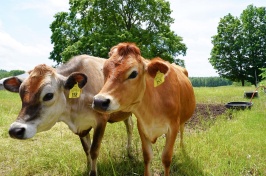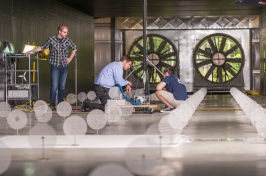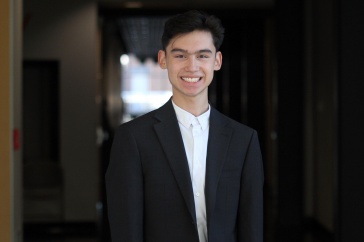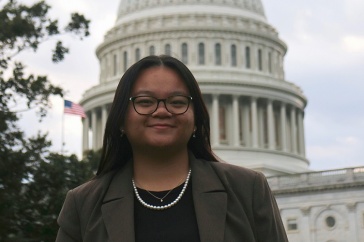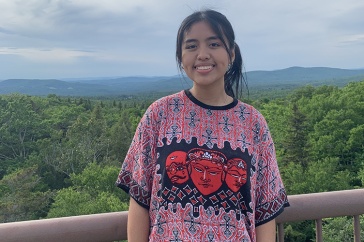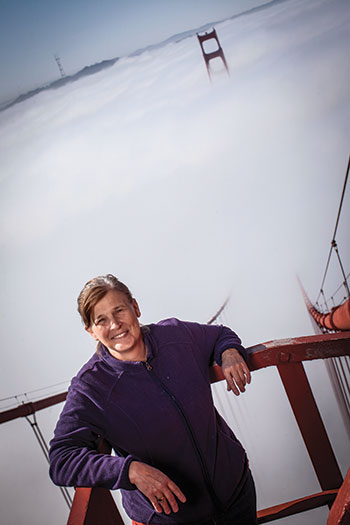 Mary Currie ’76 retired earlier this year, but she went out on top.
Mary Currie ’76 retired earlier this year, but she went out on top.
For 22 years, Currie served as chief spokesperson for a single, celebrity client: San Francisco’s fabled Golden Gate Bridge. Shortly before she retired last spring, she made a final trip up one of the bridge’s towers, which rise like graceful Art Deco skyscrapers from the bay below. “The very first time I went all the way up, I was pretty terrified,” she admits. “You’re standing on a platform surrounded by railings, so it’s very safe. But still, it’s 746 feet above the water. That’s pretty overwhelming.”
Currie grew accustomed to the heights, yet she’s still overwhelmed by the sheer grandeur of the bridge and the sweeping, 360-degree views it commands. “The bridge always looks and feels different, depending on the light, weather and time of day,” she marvels. “Whenever I worked with film crews, I would always suggest a sunrise shot, because there’s nothing like the sight of the sun coming up over San Francisco and the East Bay.”
Currie’s own story began 3,000 miles away. She grew up in Connecticut, and inherited an interest in science and the outdoors from her father, a biology teacher, and a commitment to public service from her grandmother, who was active in Democratic politics. She spent two years at UConn then transferred to UNH, where she majored in botany and minored in soil sciences. After graduating, she landed work as a field biologist at Yellowstone National Park and then as a soil mapper with the Soil Conservation Service in Colorado and Montana—and discovered she had an aptitude for “taking complex technical information and translating it in way that is meaningful for the general public.”
That skill proved essential when, after relocating to California, she joined a friend’s public affairs consulting company that specialized in transportation projects. (“You have a science background,” her friend told her. “You probably can understand these engineers much better than I can.”) After several years of helping commuters grasp the intricacies of the Bay Area Rapid Transit system and Caltrans construction projects, she was hired as the very first public information officer for the Golden Gate Bridge, Highway and Transportation District.
Currie became the go-to communications person for everything from routine transit issues like bus scheduling (“surprisingly complex,” she says) to random but regular acts of whimsy—like the foggy morning she arrived at work to discover that a group of enterprising engineering students had suspended a VW bug over the side of the bridge, or the late summer afternoon when a six-foot-tall ostrich escaped from a cargo van and brought bridge traffic to a complete halt. She developed the bridge’s online presence, creating its fact-and-photo-filled website and training bridge workers to use Twitter to provide traffic updates to the estimated 39 million vehicles that cross the bridge every year.
She also dealt with far more serious issues, like the stepped-up security measures that followed 9/11 and the long-running debate over whether to install suicide-deterrence nets below the bridge’s public walkways. While the bridge’s security team is able to intercept the vast majority of would-be suicides, since the bridge opened an estimated 1,600 people have ended their lives there. “That’s a tragedy for the people who are harming themselves, and for the bridge itself,” says Currie. She was greatly heartened this June when the district’s board of directors approved a $76 million funding plan to install the steel-mesh nets by 2017.
Most of all her work made her a passionate student of the Golden Gate Bridge’s rich history, and eventually the author of two books about its construction and engineering. “This bridge was built during the Great Depression by men who desperately needed the jobs,” says Currie, who counts interviewing some of the surviving bridge builders as one of the highlights of her tenure. “It became a symbol of innovation, of the ability to dream big and accomplish it. It gives me the chills to have been part of something so special.”
Originally published in UNH Magazine—Fall 2014 Issue
-
Written By:
Beth Brosnan | freelance writer






























